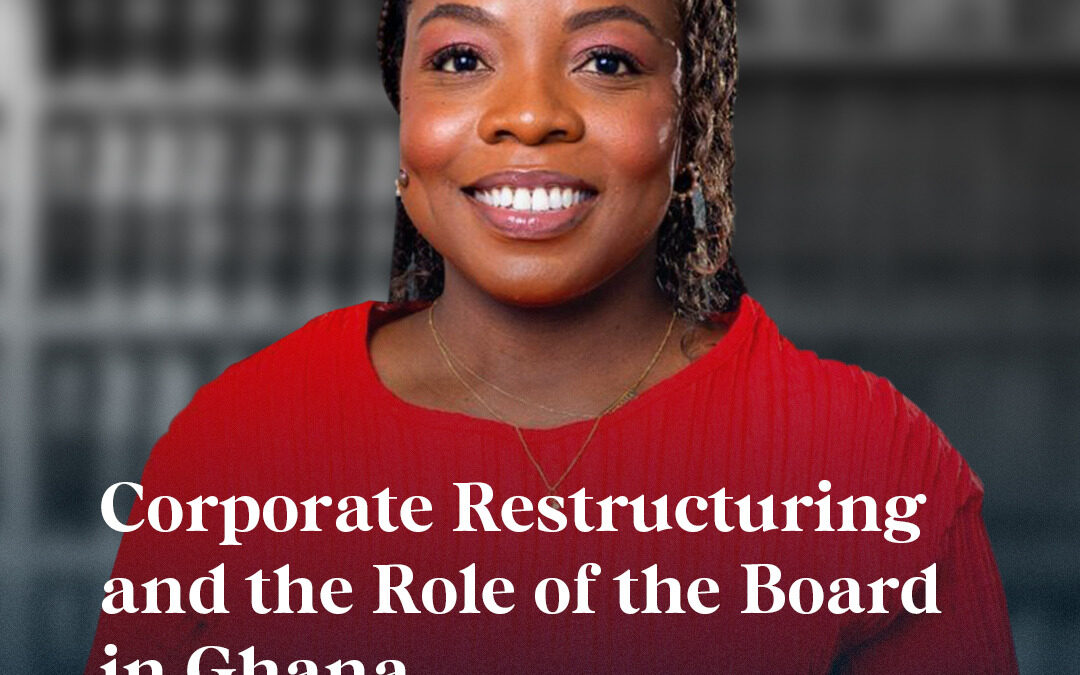
by maximus | Apr 17, 2025 | Legal Resources
Introduction
Corporate restructuring simply refers to the process in which a company makes crucial changes to its capital structure or operations, usually in financially difficult situations. For a more detailed explanation, refer to our articles on Corporate Restructuring and The Role of The Board in Ghana and The Key Role of Due Diligence in Corporate Restructuring Transactions in Ghana.
The primary goals of restructuring are to reduce debt, improve cash flow, and ensure the company remains operational in a financially stable position.
The main objectives of corporate restructuring are to reduce debt, improve cash flow, and ensure that the company continues to operate in a financially stable manner. Factors such as financial distress, mergers, acquisitions, regulatory compliance, and operational efficiency are common triggers for corporate restructuring.
In Ghana, the key legal and regulatory frameworks that govern corporate restructuring include the Corporate Insolvency and Restructuring Act, 2020 (Act 1015) and the Companies Act, 2019 (Act 992). Additionally, various industries are subject to their own specific regulations during the restructuring process.
Below are the practical steps that businesses or companies must follow when undergoing a corporate restructuring transaction in Ghana:
- Assessment of Financial Health
Before embarking on a corporate restructuring transaction, it is essential for the Board of Directors, financial advisors, and legal team to conduct a comprehensive assessment of the company’s financial position and health. This involves reviewing key aspects such as debt obligations, cash flow, operational efficiency, and overall financial stability. The findings from this assessment will help identify the underlying causes of financial difficulties, whether they stem from excessive debt, operational inefficiencies, or unfavorable market conditions.
If the company is insolvent (unable to pay debts when due or has liabilities exceeding assets), the Board must consider formal restructuring options to prevent liquidation. The company’s management should explore all possible recovery strategies, including refinancing, cost-cutting, asset sales, and negotiations with creditors before opting for formal restructuring.
- Board Approval & Engagement of a Restructuring Professional
Once financial distress is confirmed, the Board of the company must meet to deliberate on the best restructuring method. The Board shall pass a formal resolution outlining the reasons for restructuring, the method chosen, and the appointment of relevant professionals. In some cases, directors must also provide certifications ensuring that the company can remain solvent after the restructuring.
If the company is insolvent or at risk of insolvency, a licensed Insolvency Practitioner must be appointed as an Administrator or Restructuring Officer to oversee the restructuring process. These professionals play a crucial role in determining the most suitable restructuring approach, whether through administration proceedings, arrangement transactions, or mergers.
Given the complexity of corporate restructuring, early engagement of experienced advisors is essential because their expertise helps businesses implement effective restructuring strategies while minimizing risks and disruptions.
- Development of a Restructuring Plan or Proposal
The appointed administrator or restructuring officer works with creditors, shareholders, and management to draft a comprehensive restructuring plan. This plan should outline the specific steps the company intends to take to address its financial difficulties and improve its operational efficiency.
This plan typically includes: a detailed financial review of the company, a debt repayment or restructuring strategy, a proposal for asset sales, mergers, or operational changes, any changes to shareholding structures or ownership and a timeline for implementation and recovery.
The plan must focus on maximizing value for creditors, employees, and shareholders while ensuring the company remains a viable going concern.
- Engagement of Stakeholders & Seeking Approval
The restructuring plan must be presented to key stakeholders, including creditors, shareholders, employees, and regulatory authorities. In some cases, the company may need to negotiate with creditors to secure favorable terms, such as debt forgiveness or extensions on repayment schedules.
Corporate Insolvency and Restructuring Act, 2020 (Act 1015) of Ghana provides that creditors must approve a proposed restructuring plan during meetings or through formal voting processes. Shareholders’ approval may also be required, depending on the nature of the restructuring, especially if it involves significant changes in the company’s operations or ownership. Therefore, a meeting must be held where stakeholders review, discuss, and vote on the plan.
The approval thresholds for each type of restructuring method is as follows:
- Administration Plan: This requires support from a majority of creditors to proceed.
- Mergers: This requires at least 75% approval from members and creditors.
- Arrangements: This requires at least 75% approval from creditors or members, followed by Court approval.
If stakeholders reject the plan, the company may need to revise the proposal or consider liquidation of the company.
- Filing with the Office of the Registrar of Companies or the Court
Once the restructuring plan is approved by stakeholders, it must be submitted to the relevant regulatory body for approval and official registration.
For mergers, the approved merger proposal is submitted to the Office of the Registrar of Companies for review and formal registration. Whilst for arrangements, an application is made to the Court, which reviews the fairness of the proposal before granting approval.
Once approved, the restructuring plan becomes legally binding on all stakeholders.
- Implementation of the Approved Restructuring Plan & Monitoring of Progress
The company (under the guidance of the administrator or restructuring officer) proceeds with executing the approved plan.
Implementation measures may include:
- Debt restructuring agreements with creditors.
- Operational changes such as downsizing, cost-cutting, or changing management.
- Mergers or asset sales to strengthen the company’s financial position.
- Changes in shareholding or ownership structures under an arrangement.
During the implementation phase, it is essential to keep stakeholders informed about the progress of the restructuring and any challenges that arise by providing regular progress reports to the creditors, shareholders, and regulatory bodies to ensure transparency and accountability.
If challenges arise during implementation, the restructuring officer may need to adjust the plan to address emerging risks. The failure of the company to comply with the approved plan may result in legal consequences or a move towards liquidation.
- Post-Restructuring Monitoring and Evaluation
After the restructuring plan has been implemented, the business or company should continuously monitor its financial and operational performance. This involves regularly evaluating whether the restructuring efforts have achieved the desired outcomes, such as improved cash flow, reduced debt, and enhanced profitability.
A post-restructuring review can help identify areas that still require improvement, and the company can make further adjustments as necessary. This step is essential to ensure that the company remains on a path toward long-term stability and growth.
- Conclusion Exit & Return to Normal Operations
If the restructuring is successful, the business or company returns to normal operations with improved financial health.
The administrator or restructuring officer steps down, and control is handed back to the Board of Directors. The company continues operating under the new structure established during the restructuring. If the restructuring fails, the company may proceed to liquidation as a last resort, where assets are sold to repay creditors.
Conclusion
Corporate restructuring is a vital process that enables companies to overcome financial challenges and position themselves for long-term success. By following the practical steps outlined- from conducting a comprehensive assessment to post-restructuring monitoring, companies can successfully manage the restructuring process and emerge stronger, more competitive, and financially stable. With the support of legal and financial professionals, businesses can navigate complexities, mitigate risks, and secure a sustainable future.

By: Verissa Odame- Koranteng
Junior Associate
VINT & Aletheia Attorneys & Consultants

by maximus | Apr 17, 2025 | Legal Resources
As established in the landmark case Salomon v. Salomon, when a company is incorporated, it becomes a separate legal entity with perpetual succession. This means the company continues to exist even if its members or officers leave, due to death or other reasons. However, companies can face challenges and may need assistance to recover and grow, which is where corporate restructuring comes in.
This article will discuss corporate restructuring in Ghana, some different methods of corporate restructuring under Ghanaian law, and the role played by the Board of Directors in the process.
- What is Corporate Restructuring:
Corporate Restructuring is making major adjustments to a company’s financial and operational structure, often in response to financial difficulties. This may include making positive adjustments to the company’s debt, operations, or organizational setup, aimed at minimizing financial risk and improving business performance.
When a company encounters financial troubles or becomes insolvent, it may look to restructure as a way to recover, regain solvency, and prevent liquidation. The main objectives are to lower debt, boost cash flow, and ensure the company can continue functioning in a financially stable manner. Below are some of the ways a company can restructure in order to be solvent.
Administration:
A restructuring officer or a licensed insolvency practitioner is appointed as an administrator to operate under an approved restructuring agreementto take over the business and assets of a company that is insolvent or has a negative net worth, to manage and restructure the business for the company to become solvent and have a positive net worth.
The Corporate Insolvency and Restructuring Act, 2020 (Act 1015), (“CIRA”), is a crucial law in Ghana that addresses insolvency and restructuring. It provides distressed companies with the option to rescue their businesses instead of resorting to liquidation or receivership. Under CIRA, companies can remain operational as a going concern while undergoing restructuring, with oversight from a designated administrator or restructuring officer. This approach temporarily halts creditors’ actions, allowing for the development of a restructuring plan that may offer better outcomes for all parties compared to immediate liquidation. It is important to point out that this rescue provision does not apply to banks, insurance companies or any other business with special legislation.
The process of administration commences when a licensed Insolvency Practitioner is appointed. The administrator’s duty is to take control of the company’s business, assets, and affairs, investigate its operations, and seek ways to rescue the business in the best interests of creditors, employees, and shareholders. The administrator is responsible for managing the business, and preserving its value, and may choose to sell or terminate parts of the business and dispose of company property. The administrator also has the authority to exercise any powers or perform any duties that the company or its officers could perform if it were not in administration.
Mergers:
A merger occurs when one company is absorbed by another company or when two or more companies join to form a new company. In this process, all assets, liabilities, and operations of the merging companies are transferred to the receiving company or the newly formed
entity. In return, shareholders of the merging companies typically receive shares in the receiving company, sometimes along with additional cash payments.
In Ghana, specific steps must be followed for a merger to take effect:
- Board Approval: The directors of the merging companies must confirm that the merger serves the company’s best interest and that the transferee company will remain solvent after the merger. They must sign a certificate to this effect.
- Merger Proposal: A detailed merger proposal, along with relevant documents, must be shared with shareholders and creditors at least 28 days before the merger takes effect.
The proposal must be approved by at least 75% of each group (members, creditors, and other relevant stakeholders).
- Registration: The approved merger proposal and supporting documents must be submitted to the Registrar at the Office of the Registrar of Companies for official registration.
The essence of a merger is to create a stronger, more competitive business entity by combining resources and expertise, allowing companies to overcome limitations and achieve long-term success.
Arrangements:
An Arrangement is the reorganizing of a company’s structure or shares, such as consolidating or dividing shares, by an appointed restructuring officer (in this case, an insolvency practitioner) such as an Administrator or a Liquidator (in the case of a company being wound up) to improve its financial position. It is usually done when a company faces financial difficulties, such as needing to restructure. The purpose of an arrangement is to find a solution that benefits both the company and its creditors or members, helping the company avoid insolvency or liquidation and continue its operations.
The company first proposes an arrangement to its creditors or members. The company or other interested parties then apply to the Court which may order a meeting of the relevant groups of members and creditors to be held in the manner the Court directs. For the arrangement to proceed, at least 75% of creditors or members must approve it. If approved, the Registrar may appoint an insolvency practitioner to assess its fairness. After the investigation, the Court reviews the arrangement and the report before confirming it, making the arrangement legally binding on all parties. Once confirmed, the company must implement the changes, and if the arrangement involves asset transfers, the Court may give its approval. If the company fails to follow the required steps, it will face penalties.
- The Role of the Board in Corporate Restructuring
The Board of Directors plays a crucial role in corporate restructuring and below are their roles and responsibilities in the various corporate restructuring techniques:
In an Administration proceeding, Directors hold the following roles and responsibilities:
- They appoint an administrator if they believe the company is insolvent or likely to become insolvent. This decision is made by passing a board resolution, which must contain the grounds for insolvency or the likelihood of insolvency.
- They are required to assist the administrator, provide necessary information, and comply with their decision to help salvage the business for the benefit of creditors, employees, and shareholders.
- While they remain in office during administration, their powers to manage the affairs of the company are limited and they can only act with the administrator’s approval.
During a Merger transaction, Directors and required to do the following:
- They must ensure that the merger is in the best interest of the company and that the new company will be solvent post-merger, and they are required to provide a certificate to this effect.
- They are also responsible for sending merger proposals and relevant documents to members and creditors before the merger takes effect.
- They must ensure that all legal requirements have been complied with, including submitting necessary documents to the Registrar of Companies for approval and registration of the merger.
When a company undertakes an Arrangement, the Directors are responsible for the following:
- Applying to the Court for an order for a meeting between the shareholders and creditors to discuss and approve the proposed arrangement. The Court however provides the rules to be followed by all parties for this meeting.
- They must ensure the company follows the Court’s orders, such as providing required information by all parties and executing the necessary actions to implement the arrangement. Should they fail to do this, they will be required to pay a penalty, along with all officers of the company
- Conclusion:
In conclusion, corporate restructuring is more than just a lifeline for companies in financial distress; it is a powerful opportunity to reinvent and stabilize a business. Whether through administration, mergers, or arrangements, restructuring offers a path to reduce debt, revamp operations, and return to profitability. The Board of Directors plays a pivotal role in this transformative process, making key decisions, ensuring legal compliance, and collaborating with administrators to steer the company toward recovery. With strategic leadership and careful planning, restructuring can not only save a company but also position it for future growth and success in an ever-evolving business landscape.

By: Ewurama Osam Tawiah
Senior Associate
VINT & Aletheia Attorneys & Consultants

by maximus | Apr 17, 2025 | Legal Resources
Corporate restructuring is an action taken by a corporate entity to significantly modify its capital structure or operations. This has been further elaborated in our article on What is Corporate Restructuring and the Role of the Board in Ghana authored by our Senior Associate of VINT and Aletheia, Attorneys and Consultants.
In Ghana, corporate restructuring, such as mergers, acquisitions, and divestitures, is essential in shaping the business environment. However, these transactions carry inherent risks and complexities, making thorough due diligence necessary. Due diligence helps assess these risks, validate financial and operational conditions, and ensure compliance with legal and regulatory frameworks.
This article explores the primary objective of due diligence in corporate restructuring in Ghana.
What Is Due Diligence?
Due diligence in corporate restructuring means verifying, investigating, or auditing a potential deal or investment opportunity. This is essential for confirming all relevant facts and financial information, as well as validating any other claims that arise during a corporate restructuring or investment process.
The primary objectives of due diligence, as it pertains to a company subjected to corporate restructuring, include:
- Identifying potential risks and prospects;
- Assessing liabilities and obligations of the target company to be restructured;
- Evaluating legal and regulatory compliance to be completed;
- Verifying the accuracy of financial records provided by the company; and
- Understanding the cultural and organizational alignment of the target company.
Due diligence is performed before a deal is finalized to provide certainty on the value of a company. By conducting a comprehensive risk assessment, companies can develop strategies to mitigate or eliminate identified risks before completing the transaction. It is therefore conducted in some cases by the target company to be restructured as a check-measure on themselves to make informed decisions on an investment deal, and for an investor, to identify any potential liabilities and assets they will inherit.
Why Does Due Diligence Matter?
Conducting due diligence helps identify and evaluate potential risks associated with the target company. These risks may involve financial liabilities, legal disputes, regulatory non-compliance, and operational inefficiencies. Through a thorough risk assessment, companies can develop strategies to mitigate or eliminate these risks before finalizing the transaction.


by maximus | Apr 16, 2025 | News Flash
We are pleased to announce that VINT & Aletheia Attorneys & Consultants has been ranked as a Leading Firm (Tier 3) in the 2025 edition of the Legal 500 EMEA rankings. This achievement represents a significant milestone in our growth journey, following our debut as a Firm to Watch in the 2024 rankings. Additionally, we were also ranked as a Recognised Firm in the 2024 edition of the IFLR 1000.
 As we celebrate this milestone, we are proud of the strides taken and we reaffirm our commitment to delivering top-tier legal services and building long-term relationships with clients based on mutuality, trust, and the highest standard of professional ethics.
As we celebrate this milestone, we are proud of the strides taken and we reaffirm our commitment to delivering top-tier legal services and building long-term relationships with clients based on mutuality, trust, and the highest standard of professional ethics.
The elevation to Tier 3 reflects the continued confidence our clients place in us. This is what they had to say:
‘The firm takes a comprehensive approach to law, considering the broader business and personal implications of legal decisions. They have deep knowledge and experience in commercial law, enabling them to provide tailored guidance.’
‘I work with Lady-Ann Essuman. She offers exceptional legal expertise and advice, is strategic in her thinking and problem-solving, and has excellent communication and interpersonal skills.’
Read more here









 As we celebrate this milestone, we are proud of the strides taken and we reaffirm our commitment to delivering top-tier legal services and building long-term relationships with clients based on mutuality, trust, and the highest standard of professional ethics.
As we celebrate this milestone, we are proud of the strides taken and we reaffirm our commitment to delivering top-tier legal services and building long-term relationships with clients based on mutuality, trust, and the highest standard of professional ethics.